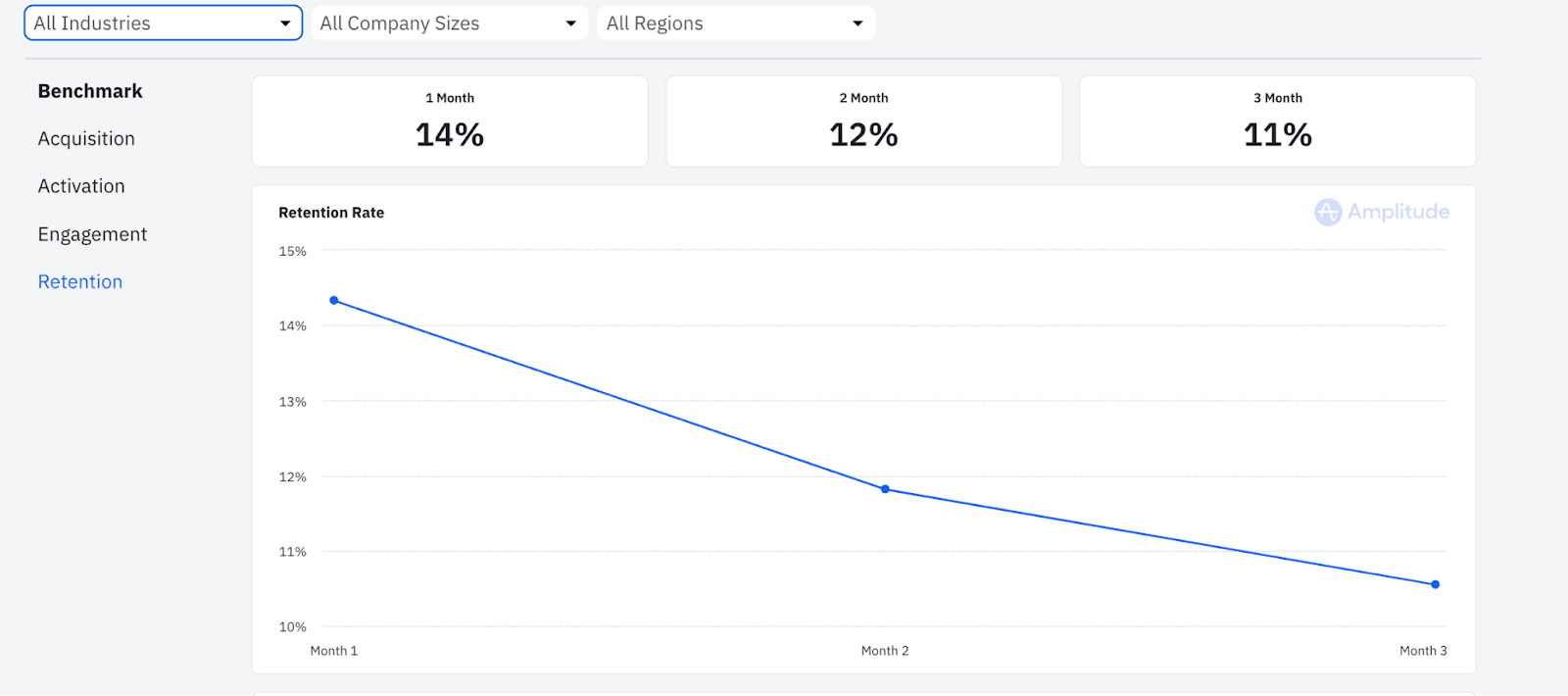Retention Rates Across Industries: FinServ, Healthcare, Media, and Beyond
Track your retention and benchmark data to keep your product competitive and at the top of users' minds.
Retention rate is the percentage of users who continue to use a digital product over a specific period, either monthly or quarterly. Retaining customers is essential for establishing long-term relationships and long-term growth. Higher retention rates often signify customer trust, leading to continued, regular product use.
You can track benchmarks to gauge your retention rate in comparison to competitors. By examining and understanding benchmarks, you’ll glean insights into industry-specific retention and digital product retention rates as a whole.
In the FinServ, Healthcare, and Media industries, tracking your retention data and benchmark data can help you keep your product competitive and at the top of users' minds.
Key takeaways
- Higher retention rates usually indicate satisfied, engaged users who value your product.
- Industry-specific benchmark data help you gauge your performance against similar products in your industry.
- To improve your retention strategy, it’s important to understand user behavior, set clear and attainable objectives, gather and implement user feedback, and monitor your rates over time.
Understanding retention rates
Your retention rate is the number of users who consistently use your digital product over a defined period, usually monthly or quarterly. People usually return to products that give them what they’re looking for. If you have a high retention rate, your customers will find consistent value in your product. If your retention rate is below industry standards, you can identify and fix the problem to better meet your customers’ needs.
When users continue using a product over time, it leads to increased customer lifetime value (CLTV), reduced acquisition costs, and a steady stream of revenue from loyal users.
Tracking industry benchmarks helps you better understand what your retention rate is telling you. On its own and without any context, having a 20% retention rate doesn’t tell you enough. But if all of your competitors have a 15% retention rate, you know your product is better at meeting customer expectations than theirs.
Industry-specific retention benchmarks
Tracking industry-specific benchmark retention rates helps you gauge your position in the market by telling you where you fall compared to industry averages.
Financial services
Amplitude’s Benchmark tool shows the average retention rates in the financial services sector are:
- 15% for one month
- 12% for two months
- 11% for three months
The retention rates in the FinServ sector are slightly higher than in other sectors. One leading factor is that fintech products are a necessity for many consumers.
Plaid’s Fintech Effect 2023 Survey found that 71% of millennials and 65% of Gen Z say economic factors like inflation “make them reliant” on digital finance products, like banking apps and investment platforms. Digital financial tools are necessary for folks who want to monitor their finances and complete transactions at any time or place.
Trust in fintech tools is also growing. People are getting more comfortable opening accounts on fintech platforms. Plaid also found that 79% of people feel comfortable opening accounts with fintech companies—close to the number of folks who feel comfortable with traditional banks (87%).
Healthcare
In the healthcare sector, Amplitude’s data shows the average retention rates as follows:
- 14% for one month
- 12% for two months
- 11% for three months
The key to retaining customers in the medical industry is prioritizing consumer expectations, such as easy access to healthcare. People want to access healthcare and their health data when and however they choose, whether in person, online, or via phone or video call.
Consumers’ preferences and needs are constantly evolving. People want more convenience and flexibility in their healthcare— virtual therapy, primary care, specialty appointments, and more.
Customers are more apt to engage with your digital healthcare product longer and more consistently when they can do a wide range of transactions. For example, digital healthcare platforms can offer patients easy appointment scheduling, the ability to send messages, and alerts to give patients flexibility and convenience.
Media
Amplitude’s data shows that retention rates in the media industry are:
- 12% for one month
- 10% for two months
- 8.5% for three months

Amplitude’s Benchmark tool shows the average retention rate for the media and telecommunications industry over the course of three months.
Media is a saturated market, and consumers have a choice of how and where to consume it, such as social media, streaming services, and news outlets. Plus, people consume media in many different ways and on many different devices, including phones, tablets, desktops, TVs, and more. Providing a seamless customer experience across all channels, devices, and mediums can help increase user retention rates.
Leading companies are focusing on making their products better than competitors to keep consumers from dropping theirs. Part of that is the content you offer consumers. For example, if Netflix has someone’s favorite show, they’re likelier to keep that subscription longer.
Meta is an example of a company meeting user content expectations. Once TikTok took over the social media scene, Meta prioritized video content. Now, users can scroll through just videos on both Instagram and Facebook just like they can on TikTok.
How to implement effective retention strategies
The key to a strong retention strategy is harnessing the data available to you. Here are a few ways to do that.
1. Understand user behavior
Learn your users’ needs, preferences, and interests so you can keep satisfaction high and ensure they have a positive experience with your product every time they use it. When you understand each part of the user journey, you can better understand user pain points and identify opportunities to improve your product.
Collect comprehensive user behavior data through analytics, surveys, and research. Identify common behaviors, transactions, and preferences. Then, develop detailed user personas representing various segments within the target audience. For example, if your product is primarily for businesses, you could segment your users by job title or department. This segmentation gives your product teams a deeper understanding of different user groups, each with unique characteristics and expectations.
2. Set clear goals and track metrics
Establish retention goals using the SMART (specific, measurable, achievable, relevant, and time-bound) approach:
- Specific: Clearly define the desired outcome.
- Measurable: Quantify retention goals with measurable metrics.
- Achievable: Consider your team’s skills and experience to ensure the goal is attainable.
- Relevant: Choose a retention goal directly related to your overall business goals.
- Time-bound: Set a reasonable deadline.
For instance, you may aim to increase retention by 3% within the next fiscal year rather than simply stating you want to raise retention rates in general.
Then, identify key performance indicators (KPIs) crucial to your product’s success; in addition to retention rate, track metrics such as churn rate, engagement, and user lifetime value. These KPIs give your team a holistic view of user behavior and product performance compared to tracking the retention rate by itself. You’ll gain more nuanced insights into why users leave, how they engage, and the overall value they bring.
Track these metrics consistently over time to evaluate your performance and gauge the effectiveness of your retention strategies. You can use an analytics tool, your CRM, or a spreadsheet to document and monitor your retention rate and other metrics.
3. Gather & implement feedback to improve engagement
Review user feedback and complaints to understand areas where you can make improvements. Integrating feedback loops within your product and user communication enables users to voice their opinions so your product addresses their needs and preferences. And if it doesn’t, you can use their feedback as suggestions for enhancements.
Implement user-friendly feedback mechanisms. You can send customer surveys, questionnaires, and requests for reviews via email or SMS. You can also ask your support agents to send surveys after any direct user communications. Encourage users to share their thoughts and suggestions openly.
Prioritize addressing common or recurring user concerns or sentiments by initiating action plans or feature adjustments based on this feedback. For instance, if you notice a lot of users leaving feedback about the navigation or functionality of your product, you can prioritize improving that over other features.
4. Document and monitor retention rates over time
Track metrics over time to uncover patterns and understand how your product’s retention performance has evolved. By doing so, you can identify trends, seasonal variations, or changes in user behavior to make informed decisions about your retention strategies.
Document retention metrics regularly using an analytics tool or CRM system to maintain an ongoing record of user retention rates and related KPIs. Track benchmark data, too. Compare your product’s retention metrics with industry benchmarks to set realistic goals and gauge your product’s performance against industry standards.
Use insights from long-term tracking to refine your product retention strategies and adapt to changing user preferences and market dynamics.
Use Amplitude to track benchmark retention rates across industries
Amplitude’s Benchmark tool gives you clear insights into retention metrics for your industry and across all industries. The information is updated every six months so that you can use the data as a baseline for your retention rate on an ongoing basis.
Benchmark data offers a comparative view, enabling you to understand where your product stands in your industry’s landscape. It provides insight into industry norms, trends, and competitive performance, helping set realistic goals.
Check out retention data for your industry for free.
Sign up for free today and start making strategic, data-driven decisions that drive growth.

Michele Morales
Senior Product Marketing Manager, Amplitude
Michele Morales is a product marketing manager at Amplitude, focusing on go-to-market solutions for enterprise customers.
More from Michele




